

15 Sites Building and Promoting Educational PBL Communities… Across School and Around the Globe. Welcome to the fourth in a series of PBL Mania Posts .

For the next few weeks I am celebrating Project Based Learning. In this post I will introduce you to some outstanding collaboration tools found on the web that can be used in the PBL classroom. Before reading please take a moment to subscribe to this 21centuryedtech Blog by email or RSS and also give me a follow on Twitter at mjgormans. You will not want to miss this series or future posts involving STEM, Flipping the Classroom, Technology Integration, Common Core, and 21st Century Skills, So Sign Up Now! As always… thanks and have a great week. – Mike Gorman (21centuryedtech) Five Keys to Rigorous Project-Based Learning. Voiceover: How will today’s children function in a dangerous world?
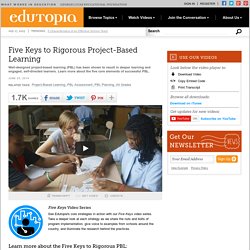
What means will they use to carve the future? Will they be equipped to find the answers to tomorrow’s problems? Resources and Tools for PBL Start to Finish. Tips for downloading: PDF files can be viewed on a wide variety of platforms -- both as a browser plug-in or a stand-alone application -- with Adobe's free Acrobat Reader program.

Click here to download the latest version of Adobe Reader. Documents to Help You Get Started. Education-2025 - Project-Based Learning. Project-Based Learning (PBL) "Tell me and I'll forget; show me and I may remember; involve me and I'll understand.
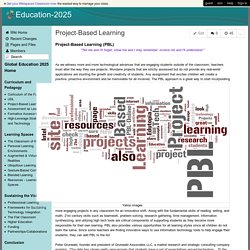
" As we witness more and more technological advances that are engaging students outside of the classroom, teachers must alter the way they use projects. Mundane projects that are strictly assessed but do not provide any real-world applications are stunting the growth and creativity of students. Any assignment that excites children will create a positive, proactive environment and be memorable for all involved. Resources for Assessment in Project-Based Learning. Project-based learning (PBL) demands excellent assessment practices to ensure that all learners are supported in the learning process.
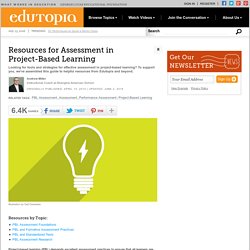
With good assessment practices, PBL can create a culture of excellence for all students and ensure deeper learning for all. We’ve compiled some of the best resources from Edutopia and the web to support your use of assessment in PBL, including information about strategies, advice on how to address the demands of standardized tests, and summaries of the research. PBL Assessment Foundations 10 Tips for Assessing Project-Based Learning (Edutopia, 2011) This comprehensive guide from Edutopia goes over many best practices for assessment, including authentic products, good feedback, formative assessment, and digital tools. Project Based Learning: Explained. Personalized PBL: Student-Designed Learning. I wrote a blog about one of the pitfalls of personalization for the ASCD Whole Child Blog.
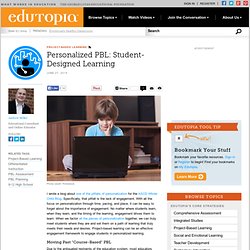
Specifically, that pitfall is the lack of engagement. With all the focus on personalization through time, pacing, and place, it can be easy to forget about the importance of engagement. PBL Pearls. PBL Pearls. Blended Learning 2.0 Infographic. Blended Learning Infograpics Blended learning is a formal education program in which a student learns at least in part through online delivery of content and instruction with some element of student control over time, place, path, and/or pace at least in part at a supervised brick-and-mortar location away from home.
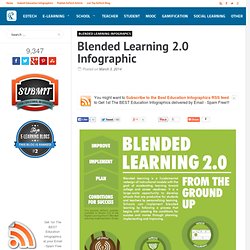
Blended learning means rethinking how class is structured, how time is used, and how resources are allocated. A shift to online delivery for a portion of the day to make students, teachers and schools more productive. Learning in multiple modalities yields more and better data that creates an integrated and customizable learning experience. The Blended Learning 2.0 Infographic serves as a visual reminder of the growing process when schools implement blended learning. Last but not least, I highly encourage you to check: Via: gettingsmart.com Embed This Education Infographic on your Site or Blog! Pour quelles raisons j’autorise les élèves à utiliser en classe leur smartphone, ou iPod, ou éventuellement tablette. L’apprentissage est en premier lieu un processus, un mouvement, une évolution.

Rien n’est figé, immuable et définitif. Les interdictions sont incompatibles avec les progrès émergents grâce aux compétences. En début d’année, j’annonce aux élèves, toujours très surpris, que la salle dans laquelle ils se trouvent est une «salle-laboratoire» et que leur cahier est un «cahier-laboratoire» : ils vont émettre des hypothèses toute l’année, tâtonner, faire des erreurs et s’améliorer. Je leur annonce qu’ils sont autorisés à travailler en groupe ou avec leurs voisins. Ils apprendront à travailler ainsi grâce au Kanban. Je leur annonce encore qu’ils sont autorisés à se lever pour prendre et utiliser un dictionnaire ou un des nombreux manuels scolaires (de français, d’histoire-géographie, de biologie ou de physique) disponibles au centre de la classe.
Les grandes lignes de l’utilisation de Kanban en classe. Kanban est une méthode appartenant au mouvement Agile.

10 Practical Ideas For Better Project-Based Learning In Your Classroom. By Jennifer Rita Nichols, TeachThought Intern Teachers are incorporating more and more projects into their curriculum, allowing for much greater levels of collaboration and responsibility for students at all levels.
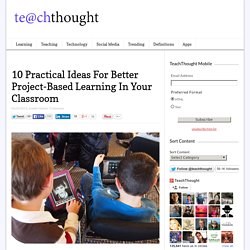
Project- based learning is a popular trend, and even teachers who don’t necessarily follow that approach still see the benefit to using projects to advance their students’ learning. Projects can be wonderful teaching tools. They can allow for a more student-centred environment, where teachers can guide students in their learning instead of using lectures to provide them with information. The increase in classroom technology also makes projects more accessible to students. Despite general agreement about the benefits of using projects and project-based learning in general, it must be noted that all projects are not created equal!
This may happen fairly often because teachers are wary about being able to assign grades to the final assignments handed in to them by students.